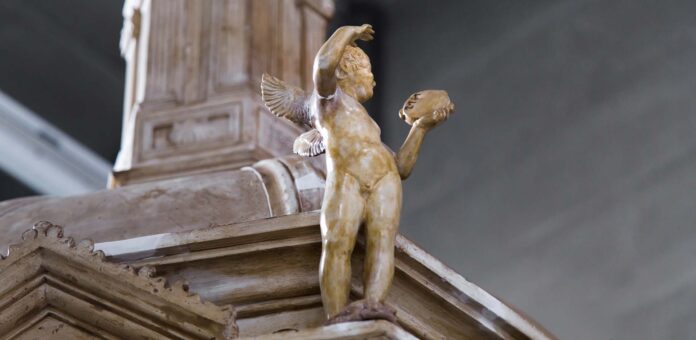In the crypt of the Bode-Museum, the area underneath the Small Dome that will serve as the gateway to the Archaeological Promenade in the coming years, the Skulpturensammlung and the Gipsformerei present a collaborative permanent exhibition. Only one object from each of the two collections will be included among the items on display in this small exhibition: the bronze statuette Putto with a Tambourine (1429) by Donatello from the Skulpturensammlung, which measures almost 40 centimetres in height, and the plaster cast model of the Baptismal Font from Siena, which stands at more than five metres and was created in the workshop of the Gipsformerei in 1876. A comprehensive research overview presented in a panoramic format will break down not only the shared history of the two objects, but also the ways in which they are connected to the history of the Staatliche Museen zu Berlin.
The Baptismal Font in the Siena Baptistery of San Giovanni is a masterpiece of the Italian Renaissance that was created between 1416 and 1434 by six sculptors, one of whom was Donatello. Donatello is responsible for creating several bronzes, including a putto that has been in the inventory of the Skulpturensammlung of the Staatliche Museen zu Berlin since 1902. Wilhelm Bode came across it on the London art market when it had been missing from Siena for centuries.
The Baptismal Font has left other traces in Berlin in addition to the bronze statuette: the Gipsformerei’s collection comprises a 59-part plaster cast model of the monument, which was cast in 1876. Not long before the model was cast, an Italian cast maker had spent several months taking plaster moulds directly from Siena’s Baptismal Font, which he then sent to Berlin. This process allowed the royal museums in Berlin to acquire plaster casts of more than 150 works from the Italian Renaissance throughout the 1870s and 1880s – and the Gipsformerei amassed a sizeable collection of moulds that are still used today to produce casts.
In the second half of the 19th century and the first half of the 20th century, plaster casts played an important role in the presentation of art and artefacts in museum. Casts of Italian Renaissance sculptures were first presented in the Neues Museum in the 1850s, and from 1911 were displayed in five of the Bode-Museum’s exhibition rooms. They are currently housed in the museum’s storage facilities, where they have faded into obscurity – and wrongly so, as this exhibition seeks to demonstrate. Donatello’s bronze Putto with a Tambourine and the monumental plaster cast model of the Baptismal Font, which was meticulously restored in 2023, are brought together in the chapel-like crypt of the Bode-Museum. The exhibition not only provides visitors with the putto’s art-historical context, but also offers them access to a piece of Berlin museum history. The exhibition is a homage to the plaster cast model in particular, exploring the many facets of the object’s biography and shedding light on the original mould taken in Siena, as well as the history of how the model was created and used in Berlin. The plaster cast model emerges as a historical work in its own right and illustrates that casts are themselves always originals.
Exhibition Publication
The exhibition will be accompanied by a publication released by Schnell + Steiner, featuring contributions from Aurelia Badde, Eckart Marchand, Ricardo Mendonça, Neville Rowley and Veronika Tocha, alongside photographs by Fabian Fröhlich, which depict the process of restoring the plaster cast model and its innate characteristic features.
Curatorial Team
The exhibition is curated by Neville Rowley and Veronika Tocha.
The restoration and reconstruction of the model was carried out by Aurelia Badde in collaboration with Judith Kauffeldt and the Gipsformerei, in particular Günter Fromme, Stefan Kramer and Thomas Schelper, as well as Lothar Bogdanski, Isabelle Irrgang, Daniel Meyer and Robin Schulz.
The restoration has been generously funded by the Ernst von Siemens Kunststiftung.
The exhibition was made possible by the Kaiser Friedrich Museumsverein, with support from Museum & Location.
The publication was realised by the Ernst von Siemens Kunststiftung and the Kaiser Friedrich Museumsverein.
A permanent exhibition of the Skulpturensammlung and the Gipsformerei of the Staatliche Museen zu Berlin
Source : Museen zu Berlin













